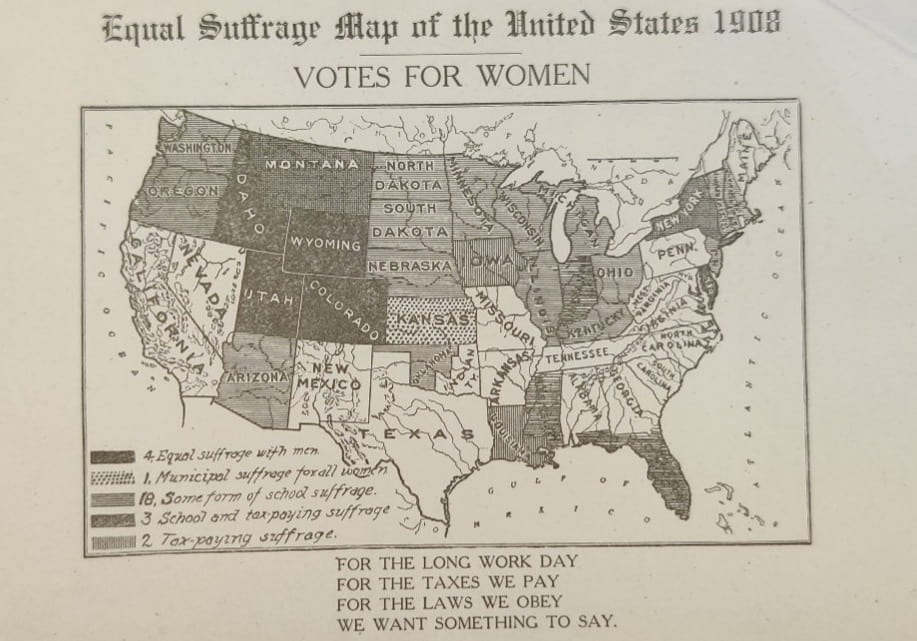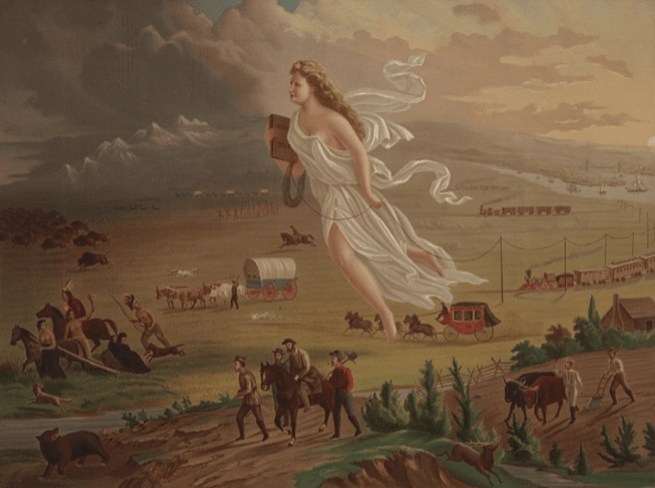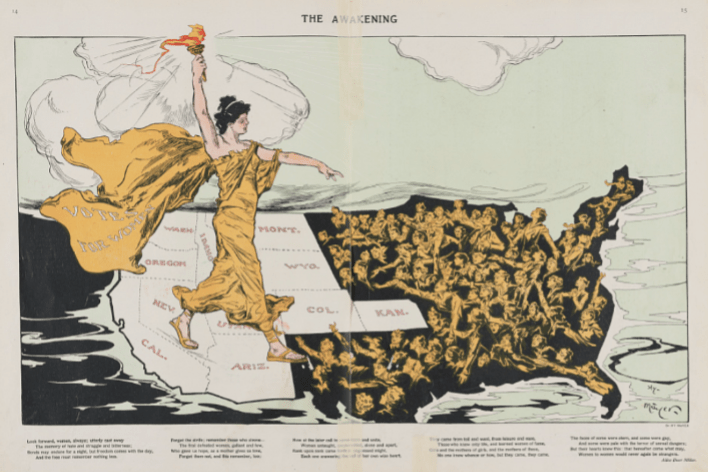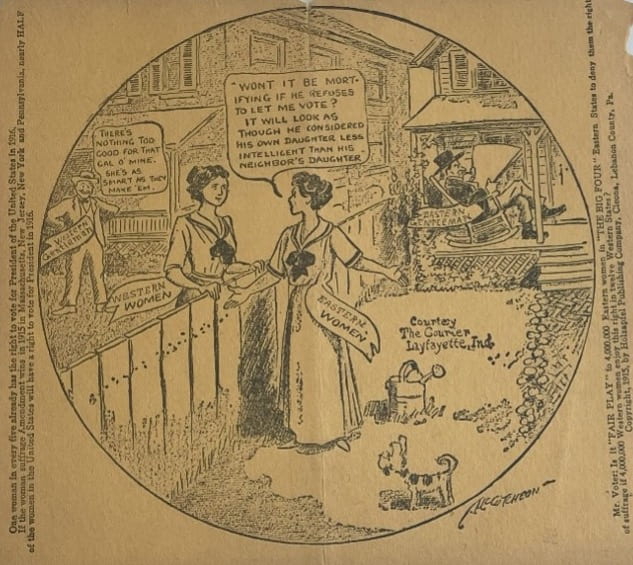by Jordyn H. May
Although not responsible for the creation of the first suffrage map, California suffragists swiftly adapted the idea of “an equal-suffrage map” to fit their local situation and popularized it nationally (March 14, 1908, p. 42). In 1908, Alice Park (1861-1961), state publicity chairman for the California Equal Suffrage Association (CESA) adapted and sold the first suffrage map for the California context, encouraging other suffragists to use it as well, representing a development that had long-lasting impact on the American woman suffrage movement. On the first California map, states that had equal voting rights with men appeared in black, states that did not were colored white, and states with some form of in-between suffrage such as school suffrage, shaded with patterns. Over time, the color of the states flipped so equal suffrage states were colored white and non-equal suffrage states shaded black. This map was designed for a California audience, claiming “California women have no votes,” illustrating visually how “California was not ‘on the map’” (p. 225). This essay examines how the suffrage map became a visual representation of the movement of woman suffrage from the West to the East, and, further, how political progressiveness flowed from, as people of the nineteenth and twentieth centuries believed, the “uncivilized” frontier to the “civilized” East.

Scholars such as Marianna Pavlovskaya and Kevin St. Martin have examined how feminists adopted cartography to “disrupt the privileged positions and products of cartography” and to advance their social justice causes. Maps have historically been used to denote power, with early maps centering Europe on the world, supporting masculine colonial practices. Feminists have now developed alternative mapping practices to bring attention to issues affecting women. Geographer Christina Elizabeth Dando analyzes suffragists’ adoption of the suffrage map as an early representation of social justice mapping and has claimed that this suffrage map became an important symbol of the suffrage movement as it “suggest[ed] the inevitability of suffrage spreading all the way across the United States” (p. 230).
Historian Frederick Jackson Turner discussed the so-called closing of the frontier in his 1893 article, “The Significance of the Frontier in American History,” which defined the field of Western American history. In his article, he noted that the 1890 census report proclaimed the closing of the frontier as enough people had settled in the area (two per square mile) that the West could no longer be considered a frontier space. Turner claimed that the closing of the frontier marked the end of an era of American history since “[t]he existence of an area of free land, its continuous recession, and the advance of American settlement westward, explain American development.” He asserted that the frontier had “furnish[ed] the forces dominating American character” such as nationality, individualism, and democracy. Turner’s thesis was ethnocentric and nationalistic, focusing only on white men and ignoring Native Americans, Hispanics, French Canadians, Asians, and all women (p. 21). As historian Patricia Limerick notes, his thesis depended on a single point of view, “that the observer stand in the East and look to the West” (p. 25-26). Despite the great issues with his thesis, it nevertheless had a large impact as politicians increasingly embraced imperialist policies to create a new frontier, and the myth of the American West as “wild” and “wooly,” as “uncivilized” continued to hold the popular imagination (p. 141). Limerick, instead, views the West as a place, not an ambiguous term as the frontier, which was full of people “who considered their homelands to be the center, not the edge.” (p. 26).

Suffragists were no doubt influenced by Turner’s thesis as his ideas of the frontier permeated American culture, but they also attempted to center the West in the suffrage movement. As suffrage news headed East from California through suffragists from around the country, ideas of “civilization,” “conservatism,” and “progressivism,” continually emerged. Gradually, their notions of civilization and progressivism negated images of an unsettled frontier, replacing them instead with images of a progressive space that developed as a paradise for women. Americans in the last half of the nineteenth century, along the lines of Turner, viewed progress and civilization as moving from East to West with the expansion of the transcontinental railroad, conquering and assimilation of Native American peoples and lands, and the mass migration of people to the West. Yet, suffragists imagined new forms of progress and civilization, which moved from West to East. The rhetoric of the “progressivism” of the “uncivilized” West versus the “conservatism” of the “civilized” East formulated the ideological boundaries between regions. These boundaries informed the creation and makeup of the suffrage map as suffragists began to visualize these regional dimensions in the twentieth century.
Susan B. Anthony (1820-1906), president of the National American Woman Suffrage Association (NAWSA), in 1895 initially “expressed surprise” at the ability of the California women to give such intelligent speeches, but “declare[d] publicly that the papers of the Pacific Coast women were equal if not superior to any she had ever listened to” (June 15, 1895, p. 186; June 20, 1895, p. 203, 208). As California suffragist Sarah Severance explained, “Eastern people cannot realize that California is forty-five years old, that bright people have come from all the world, and that attrition with other nations has often brought us good” (June 15, 1895, p. 186). “Bears do not roam the streets,” she continued, “gentlemen do not dress in red flannels and pistols, and California is nearer a paradise for fortunate women than any other spot on earth. If our constitutional amendment to enfranchise women carries, we shall be enviable mortals” (June 15, 1895, p. 186).
Severance also described how the pioneer experience affected how society developed in the West. She explained that:
A new State has some advantages in the work. Society has not yet stratified, not only may the cat look upon the king, but they get so jumbled up in a new country that they influence each other. Then people cannot migrate three thousand miles, if they know anything, without finding out the difference between principle and prejudice; and where so many of different sections, training, and race come together, new ideas will find lodgments. In a new country women are in a minority and usually more valued, they have extended privileges, necessity often compels unusual service and all helps to promote hospitality to the new thought (July 4, 1895, p. 215).
Severance moved to California in 1862 from New York and understood the difficulties of the journey west and how it caused the relationships between men and women to change. “Men who know how the women of early days drove the teams across the plains; how they were stranded in Death Valley, how they ‘hoofed it,’ as they picturesquely say, over the desert, carrying the baby, with a few last drops of water to keep it alive, ought to be a unit for justice,” she eloquently described (October 3, 1896, p. 320).
With the dawn of the twentieth century came developments in technology including new mass advertising techniques which suffragists readily embraced. The suffrage map created and sold by Alice Park and the CESA was the first time that suffragists visualized the movement of political progressiveness on women’s issues from West to East, and it left a lasting impression. Partly due to Park’s behest, the map soon became the image of the suffrage movement in the 1910s. She persuaded the officers of NAWSA to use the map in their letterhead, an idea which they initially rejected because NAWSA would have to pay for new stationery every time a state won suffrage. NAWSA did eventually adopt the map as it became part of the letterhead by 1912, after California women had won the right to vote in 1911. Park prided herself on her idea in a letter to a close friend in 1913, “Nevada is issuing the suffrage map on letterheads—envelopes—[and] several kinds of printed matter. This was my advice—more than a year ago. The Nat. Suff. Assn. is using the map more [and] more now—it makes me smile to remember how long it took to get them started… the others have to follow after the start is made.”
New York activists especially embraced the imagery of the suffrage map for their campaigns in 1915 and 1917. One New York woman created a walking suffrage map by taking an outline map of the country and “colored it in water colors in strong, striking tints—full suffrage States, rich blue: partial suffrage, pink: non-suffrage, brown” (February 1, 1913, p. 40). She wore this map as a sandwich board as she walked her neighborhood and found that “[t]he colored map is… very valuable, as many people receive impressions more strongly through the eye than the ear” (February 1, 1913, p. 40). Carrie Chapman Catt (1859-1947), former president of NAWSA and leader of the New York state campaign, urged all suffrage workers to use the idea of the map to convert men to the cause. “I believe there is no better process of doing the canvass than to make a little talk about the map,” she said, “[m]ost men do not know that women vote anywhere and when they learn that it is a discrimination against New York women to hold them unenfranchised, it makes a very deep impression.”

Suffragists and artists expanded from the simple outline map to include more symbolic meanings and ideas. “The Awakening” by Henry Mayer was first published in February 1915 in Puck. This double page color cartoon pictured a woman in gold robes labelled “Votes for Women” bearing the torch of liberty. She strode across the Western United States which was colored white. She pointed to the East which was shaded black and where women were desperately reaching out to her. The cartoon illustrated the awakening of the nation to the principle and justice of woman suffrage. A very similar cartoon, published in the National Woman’s Party’s publication The Suffragist the same year, represented a graceful woman in robes labelled with the states that had voting rights holding a cornucopia that spilled “Votes for Women” over the Eastern United States. The cartoon proclaimed, “Her Cornucopia Will Ere Long Bless the Whole Map!”

Suffragists also began to use the success of woman suffrage in the West to chastise the more “civilized” and “conservative” Eastern men for not being as gracious towards women as the “uncivilized,” yet “progressive” Western men of the frontier had been. In a cartoon reprinted from The Courier in Lafayette, Indiana, a woman representing Western Women and a woman labelled Eastern Women talked over a fence dividing their backyards. A Western Gentleman stood proudly with his fists on his hips in the background and proclaimed, “There’s nothing too good for that gal o’mine. She’s as smart as they make ‘em.” Meanwhile, an Eastern Gentleman sat in a rocking chair on the porch with his back to the women reading a blank newspaper while the Eastern Women claimed “Won’t it be mortifying if he refuses to let me vote? It will look as though he considered his own daughter less intelligent than his neighbor’s daughter.” The Western Gentleman, in his speech, was shown as supportive of women’s rights, but also less intelligent. On the other hand, the Eastern Gentleman, who prided himself on being more intelligent than the men of the “wild west,” was reading a blank newspaper. There was also no physical difference between the Eastern and Western women. They both wore simple white dresses with a bow in front, and had their dark hair pulled back in the same fashion, impressing on the viewer that the only difference between these women was geography, illustrated by the fence separating them.

Although the suffrage map had “become a nightmare” to the National Woman Suffrage Publishing Company by 1917 due to more frequent updates, the Company published a new “Victory Map” each time a state won any voting rights until the ultimate ratification of the Nineteenth Amendment in August 1920 (p. 146-147). The image of progressive ideas traveling from West to East has had a long-lasting effect.
Even in 2023 the policies formulated by California and viewed as progressive have a nation-wide effect. Scholars have begun to call California’s ability to shape national policy the “California effect.” California has some of the most widely copied laws in the nation including regulation of the auto industry, labor and consumer protections, climate protection, and limiting corporate power. Considering California has the fifth largest economy in the world, companies often adopt California’s laws since that is easier than creating two separate policies and products. For many Americans today it appears that progressive ideals still flow from West to East, out of the former frontier.
Jordyn H. May is a PhD Candidate in American History at Fordham University in New York City. Her work examines the nature and evolution of relationships between the Eastern and Western branches of the American woman suffrage movement. Her primary research interests are woman suffrage and women’s political culture in the Gilded Age and Progressive Era.
Edited by Thomas Furse
Featured image: “The Awakening” by Henry Mayer, February 1915. Source: Library of Congress.



1 Pingback